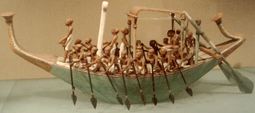Wooden tomb model
Wooden tomb models were an Egyptian funerary custom throughout the Middle Kingdom in which wooden figurines and sets were constructed to be placed in the tombs of Egyptian royalty. These wooden models represented the work of servants, farmers, other skilled craftsman, armies, and religious rituals.[1] The different types of models served as symbols and were believed to perform various functions for the deceased.[2]
Origin
During the Protodynastic and Early Dynastic period (3200–2686 BC) the funerary sacrifice of servants was practiced to provide for the deceased royal retainers to accompany him into the afterlife.[3] At Abydos and Saqqara (3100–2890 BC), the tombs of 1st-Dynasty rulers suggest this practice with shared-roof subsidiary burials surrounding the tombs.[4] The practice of human sacrifice was later superseded by the wooden model representations of servants instead.[5]
Egyptian royalty likely felt a pressing need for servants in the afterlife, having been waited on hand and foot by them during their entire lifetime. This seems to have led to the diverse variety of models found in tombs to perform various functions.[6] Originally royal tombs were provided only one model servant, but as time went on the number of wooden models increased, some containing 365, one for every day of the year.[7] Additional scenery, animals, and objects also began to be provided.[8] As the practice of wooden models moved into the New Kingdom, numbers continued to increase. More than 700 figurines are said to have populated the tomb of Sety I (1294–1279 BC).[9]
Variety of models

As the practice of funerary models increased in popularity, especially during the Middle Kingdom, so did the variety of the models and their functions. In addition to models of servants, models of bakeries, farms, granaries, factories, military, and religious worship complete with workers, tools, weapons, and animals were made. Each model had a different purpose in the belief of the Egyptians and was provided to perform its specific function. Model houses were included to ensure existence in the afterlife. Farmers, artisans, and craftsmen models were said to increase the material wealth of the individual. If the tombs resident needed to perform a specific task in the afterlife, a wooden model would be included to perform that task for him. Funerary boat models reflected the mythological beliefs of the Egyptians, that they would help to further the deceased's progression in the underworld.[10] The best known wooden models come from the tomb of the chancellor Meketre, over half of which are funerary boats.[11]
Later usage
During the New Kingdom and into the Late Period (747–332 BC), the wooden models were developed into what are known as Shabti or Ushabti. Shabti, similarly, were funerary models provided in the tombs of Egyptian royalty to spare the tomb owner from labor in the next life. Shabtis were inscribed with chapter 6 of The Book of the Dead providing them with instructions that enabled them to perform their labors. "Overseer" models were also provided to ensure the shabti performed their labors. Shabtis were composed of wood, clay, wax, stone, bronze, faience, or glass. The practice died out during the Ptolemaic period (332–30 BC).[12]
References
- Kathryn A. Bard, Steven Blake Shubert, Encyclopedia of the Archaeology of Ancient Egypt, pp.266f, Routledge, 1999
- Bard & Shubert 1999, pp.266f.
- Ian Shaw & Paul Nicholson, The British Museum Dictionary of Ancient Egypt, p.134, 1995, British Museum Press
- Shaw & Nicholson 1995, p.134
- Shaw & Nicholson 1995, p.134
- "Ancient Egypt: Funerary Objects", Kibbutz Reshafim, n.p., [cited 9 Dec. 2014]. Online: http://www.reshafim.org.il/ad/egypt/funerary_practices/funerary_objects.htm
- Shaw & Nicholson 1995, p.266
- Kibbutz Reshafim, n.p.
- Shaw & Nicholson 1995, p.266
- Kibbutz Reshafim, n.p.
- The British Museum, "Wooden model of a granary with figures", The British Museum, n.p., [cited 9 Dec. 2014]. Online: https://www.britishmuseum.org/explore/highlights/highlight_objects/aes/w/wooden_model_of_a_granary_with.aspx
- Shaw & Nicholson 1995, p.267